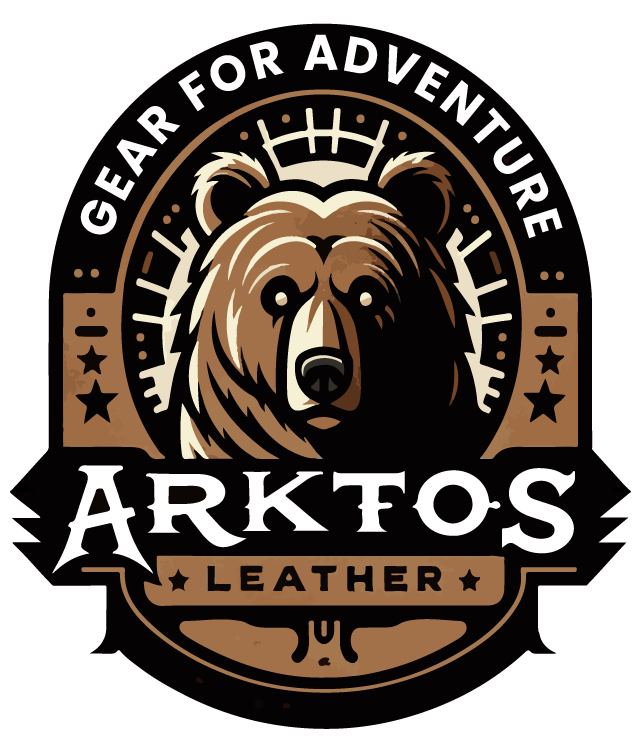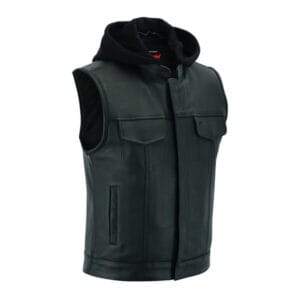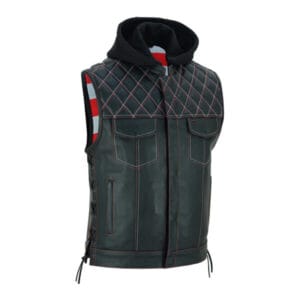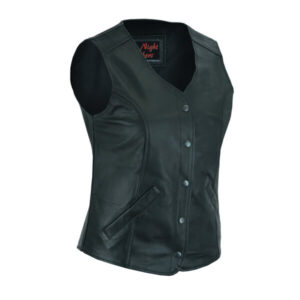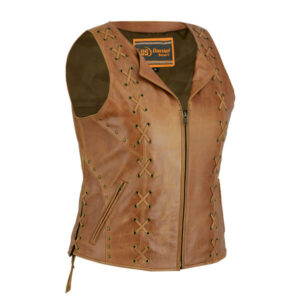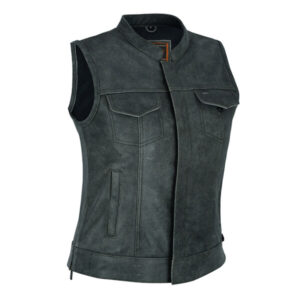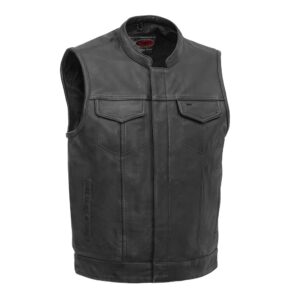Motorcycle vests are more than just a fashion statement; they are a crucial piece of gear for riders, offering protection and functionality on the road. However, many riders overlook the importance of properly breaking in their motorcycle vests. In this comprehensive guide, we’ll delve into the significance of breaking in your motorcycle vest and provide insights into understanding the materials used in their construction.
Men’s Removable Hood Naked Cowhide Vest w/ Concealed Carry
a. Importance of Properly Breaking In Gear
Breaking in your motorcycle vest is essential for several reasons. Firstly, it ensures optimal comfort and fit. A new vest may feel stiff and uncomfortable initially, but through the process of breaking it in, the materials become more flexible, conforming to your body shape and movements. This enhances comfort during long rides, reducing the risk of chafing or irritation.
Secondly, breaking in your motorcycle vest helps improve its protective capabilities. Vests are often constructed from durable materials such as leather or textile blends, designed to withstand abrasion and impact in the event of a crash. However, these materials may be rigid when new, limiting their ability to provide full protection. By breaking in the vest, you allow the materials to loosen up and mold to your body, ensuring a better fit and maximizing the protective benefits of the gear.
Lastly, proper break-in ensures longevity and durability. Motorcycle vests are an investment, and by taking the time to break them in correctly, you extend their lifespan. Through regular use and movement, the materials become more supple and resilient, maintaining their integrity over time. This means you’ll get more value out of your vest, enjoying its benefits for years to come.
b. Understanding Motorcycle Vest and Their Materials
To fully appreciate the importance of breaking in a motorcycle vest, it’s essential to understand the materials commonly used in their construction.
1. Leather Vests
Leather vests are a popular choice among riders due to their durability and classic aesthetic. However, new leather vests can feel stiff and restrictive, particularly around the shoulders and arms. To break in a leather vest, it’s recommended to wear it regularly during rides and engage in gentle stretching exercises to loosen up the material. Additionally, applying a leather conditioner can help soften the leather and accelerate the break-in process.
Men’s Leather/Denim Combo Biker Vest Blue
2. Textile Vests
Textile vests offer versatility and functionality, often featuring waterproof or breathable materials for enhanced comfort. While textile vests may not require as much break-in as leather, they still benefit from some initial wear to conform to your body shape. Simply wearing the vest during short rides or around the house can help soften the material and improve overall comfort.
3. Mesh Vests
Mesh vests are ideal for warm weather riding, providing excellent airflow and ventilation to keep you cool on hot days. Breaking in a mesh vest involves wearing it regularly to allow the material to adjust to your body shape. Additionally, gently stretching the mesh fabric can help accelerate the break-in process and ensure a comfortable fit.

Men’s Honeycomb Stitch Cowhide Leather Vest
Preparing for the Breaking-In Process
Before diving into the exciting journey of breaking in your motorcycle vest, it’s essential to properly prepare the gear and identify any areas that may require adjustment. By taking the time to clean, inspect, and assess your vest, you’ll ensure a smooth and effective break-in process.
a. Cleaning and Prepping the Motorcycle Vest
Start by giving your riding vest a thorough cleaning to remove any dirt, dust, or debris that may have accumulated during storage or transportation. Depending on the material of your vest, you may need to use specific cleaning products or techniques to maintain its integrity.
For leather vests, gently wipe down the surface with a damp cloth to remove surface dirt, being careful not to saturate the leather. Avoid using harsh chemicals or abrasive cleaners, as they can damage the leather’s finish. Once cleaned, allow the vest to air dry naturally, avoiding direct sunlight or heat sources that can cause the leather to dry out and crack.
Textile and mesh vests can typically be machine washed or hand washed using mild detergent and cold water. Follow the care instructions provided by the manufacturer to ensure proper cleaning and drying procedures. Once cleaned, inspect the vest for any signs of wear or damage, such as loose seams or frayed edges, and address them before proceeding with the break-in process.
b. Identifying Potential Areas for Adjustment
Next, take the time to assess your motorcycle vest for any areas that may require adjustment to achieve the perfect fit. Pay close attention to areas such as the shoulders, chest, and waist, where the vest may feel tight or restrictive.
If your vest features adjustable straps or lacing, experiment with different settings to customize the fit to your body shape. Loosen or tighten the straps as needed to achieve a comfortable yet secure fit that allows for freedom of movement. Additionally, consider adding foam or gel inserts to provide extra padding and support in areas prone to pressure or discomfort.
Take note of any potential hot spots or pressure points where the vest may rub or chafe during wear. These areas may require additional attention during the break-in process to ensure optimal comfort and performance on the road.
Men’s Adjustable Diamond Stitch Hooded Leather Vest
Methods for Breaking In a Motorcycle Vest
Breaking in your motorcycle vest is a crucial step in ensuring optimal comfort, fit, and performance on the road. While natural wear and daily usage are effective methods for breaking in your vest over time, there are also accelerated techniques that can expedite the process. In this section, we’ll explore both natural and accelerated methods for breaking in your motorcycle vest.
a. Natural Wear and Usage
1. Daily Wear Techniques
One of the simplest and most effective ways to break in your motorcycle vest is through daily wear and usage. Wear your vest regularly during short rides or while performing everyday activities to allow the materials to gradually conform to your body shape and movements. Over time, the natural wear and flexing of the vest will help soften the materials and enhance comfort.
2. Long Rides and Their Impact
Long rides offer an excellent opportunity to break in your motorcycle vest while enjoying the open road. Extended periods of riding allow for continuous movement and pressure on the vest, helping to stretch and mold the materials more quickly. Consider planning longer rides or weekend trips to accelerate the break-in process and ensure that your vest is comfortable and broken in before embarking on extended journeys.
b. Accelerated Break-In Techniques
1. Leather Conditioning Methods
For leather biker vests, conditioning the leather is an effective way to soften the material and accelerate the break-in process. Use a high-quality leather conditioner or balm to moisturize the leather and restore its suppleness. Apply the conditioner evenly to the surface of the vest, paying particular attention to areas that may feel stiff or tight. Allow the conditioner to penetrate the leather for several hours or overnight before wiping off any excess product. Repeat this process regularly to keep the leather soft and pliable, speeding up the break-in process and maintaining the integrity of the material.
2. Stretching and Molding Techniques
Another accelerated method for breaking in your motorcycle vest is through stretching and molding techniques. Focus on areas of the vest that feel tight or restrictive, such as the shoulders, arms, or sides. Gently stretch the material using your hands or by wearing the vest over layers of clothing to encourage flexibility and looseness. You can also use specialized stretching devices or techniques such as steaming or heating to help reshape the material and improve overall comfort.
Women’s 3/4 Long Body Motorcycle Vest with Plain Sides
Common Mistakes to Avoid When Breaking In a Riding Vest
While breaking in your motorcycle vest is essential for optimal comfort and fit, it’s important to approach the process with care and attention to avoid common mistakes that can compromise the integrity of the gear. In this section, we’ll highlight two key mistakes to avoid when breaking in your vest.
a. Overstretching or Over Conditioning
One of the most common mistakes riders make when breaking in their leather biker vest is overstretching or over conditioning the material. While it’s natural to want to accelerate the break-in process, excessive stretching or conditioning can weaken the fabric and lead to premature wear and tear.
Avoid pulling or stretching the vest beyond its natural limits, as this can cause seams to rip or materials to become misshapen. Similarly, be cautious when applying conditioning products to leather vests, as overuse can saturate the leather and cause it to lose its structural integrity.
Instead, take a gradual approach to breaking in your vest, allowing the materials to adjust naturally to your body shape and movements. Use conditioning products sparingly and follow the manufacturer’s recommendations for application and frequency.
b. Using Incorrect Products or Methods
Another common mistake is using incorrect products or methods when breaking in your motorcycle vest. Not all conditioning products are suitable for every type of material, and using the wrong product can damage or discolor your vest.
Before applying any conditioning products, check the manufacturer’s recommendations and ensure that the product is compatible with the material of your vest. For example, leather vests may require specialized leather conditioners, while textile or mesh vests may benefit from water-based or silicone-based treatments.
Additionally, avoid using harsh chemicals or abrasive cleaners on your vest, as these can strip away protective coatings or damage the fabric. Stick to gentle cleaning methods and products specifically designed for motorcycle gear to preserve the integrity of your vest.
Women’s Adjustable Brown Zippered Vest with Lacing Detail
Assessing Break-In Progress
As you embark on the journey of breaking in your motorcycle vest, it’s essential to periodically assess the progress and make any necessary adjustments along the way. In this section, we’ll explore the signs of a well-broken-in vest and adjustments to consider during the break-in process.
a. Signs of a Well-Broken-In Leather Vest
Knowing when your motorcycle vest is adequately broken in is crucial for achieving optimal comfort and performance on the road. Here are some signs to look for to determine if your vest has reached the desired level of break-in:
- Increased Flexibility: A well-broken-in vest will feel more flexible and supple, conforming comfortably to your body shape and movements. You should notice greater freedom of movement and reduced stiffness compared to when the vest was new.
- Enhanced Comfort: As the materials of the vest soften and mold to your body, you’ll experience improved comfort during rides. Any initial areas of tightness or discomfort should diminish, allowing for a more enjoyable riding experience.
- Smoothness of Seams: Seams that were initially stiff or prominent may become less noticeable as the vest breaks in. The edges of the vest should feel smoother against your skin, reducing the risk of chafing or irritation.
- Natural Patina (for Leather Vests): If you have a leather vest, you may notice the development of a natural patina over time. This is a sign of quality leather that has aged gracefully, adding character and depth to the appearance of the vest.
b. Adjustments to Make During the Process
Throughout the break-in process, it’s essential to remain attentive to any areas of discomfort or tightness and make adjustments as needed. Here are some adjustments to consider during the break-in process:
- Loosening or Tightening Straps: If certain areas of the vest feel too tight or too loose, adjust any straps or lacing to customize the fit to your body shape. This can help alleviate pressure points and ensure a comfortable and secure fit.
- Adding Padding or Inserts: For areas that experience excessive pressure or discomfort, consider adding foam or gel inserts to provide extra padding and support. These inserts can help distribute pressure more evenly and reduce the risk of soreness or fatigue.
- Reapplying Conditioning Products: If you have a leather vest, periodically reapply conditioning products to maintain the softness and flexibility of the leather. This can help prevent drying out and ensure that the vest remains supple and comfortable over time.
Women’s Premium Single Back Panel Gray Concealment Vest
Troubleshooting and Dealing with Discomfort
While breaking in your motorcycle vest, it’s common to encounter discomfort or fit issues along the way. In this section, we’ll explore strategies for handling discomfort during the break-in process and addressing fit issues to ensure a comfortable and personalized fit.
a. Handling Discomfort During Break-In
Dealing with discomfort during the break-in process is a normal part of adjusting to new gear including boots and jackets. Here are some tips for handling discomfort effectively:
- Take Breaks: If you experience discomfort while wearing your vest, take breaks as needed to allow your body to rest and recover. Gradually increase the duration of wear over time to build up tolerance and reduce discomfort.
- Use Padding: If certain areas of the vest cause discomfort or irritation, consider using padding or cushioning to provide relief. Foam or gel inserts can help alleviate pressure points and enhance comfort during the break-in process.
- Apply Topical Treatments: For areas of chafing or rubbing, apply topical treatments such as petroleum jelly or anti-chafing creams to reduce friction and irritation. These treatments can help soothe sensitive skin and prevent discomfort during wear.
b. Addressing Motorcycle Vest Fit Issues
If you encounter fit issues with your motorcycle vest, it’s essential to address them promptly to ensure optimal comfort and protection. Here are some steps to take to address fit issues effectively:
- Adjust Straps and Fastenings: Start by adjusting any straps or fastenings on the vest to customize the fit to your body shape. Loosen or tighten straps as needed to achieve a snug yet comfortable fit that allows for freedom of movement.
- Consider Alterations: If the fit issues persist, consider taking the vest to a professional tailor or seamstress for alterations. They can make adjustments to the vest, such as tapering the sides or shortening the length, to improve the overall fit and comfort.
- Evaluate Sizing: If the fit issues are significant, it may be necessary to reassess the sizing of the vest. Refer to the manufacturer’s sizing chart and consider trying on different sizes to find the best fit for your body shape and riding preferences.
Mens Black Leather SOA Anarchy Outlaw Biker Vest
Maintenance and Care Post Break-In
Once you’ve successfully broken in your motorcycle vest, it’s essential to maintain its condition to ensure long-lasting performance and durability. In this section, we’ll explore maintenance and care routines to follow post-break-in to keep your vest looking and performing its best.
a. Cleaning and Conditioning Routines
Regular cleaning and conditioning are essential for preserving the integrity of your motorcycle vest and prolonging its lifespan. Follow these simple routines to keep your vest clean and well-maintained:
1. Cleaning:
- Regular Dusting: Use a soft brush or cloth to remove any dust or debris from the surface of the vest. This helps prevent dirt buildup and maintains the appearance of the vest.
- Spot Cleaning: For stains or spills, spot clean the affected areas using a mild detergent or leather cleaner. Gently dab the stain with a damp cloth, taking care not to saturate the material.
- Machine Washing (if applicable): If your vest is machine washable, follow the manufacturer’s instructions for washing and drying. Use a gentle cycle and mild detergent, and avoid using bleach or harsh chemicals that can damage the fabric.
2. Conditioning:
- Leather Conditioning: If you have a leather vest, regularly condition the leather to keep it soft and supple. Apply a leather conditioner or balm to the surface of the vest, following the manufacturer’s instructions for application and frequency.
- Textile/Mesh Care: For textile or mesh vests, follow the manufacturer’s recommendations for care and maintenance. This may include using water-based or silicone-based treatments to restore water repellency and enhance durability.
b. Preservation Techniques for a Long-lasting Biker Vest
In addition to regular cleaning and conditioning, consider implementing the following preservation techniques to ensure your motorcycle vest remains in top condition:
- Storage: When not in use, store your vest in a cool, dry place away from direct sunlight and moisture. Hang it on a sturdy hanger to help maintain its shape and prevent wrinkles or creases.
- Avoiding Abrasive Surfaces: Be mindful of where you place your vest to avoid contact with abrasive surfaces or sharp objects that can cause scratches or damage.
- Inspecting for Damage: Periodically inspect your vest for signs of wear or damage, such as loose seams, frayed edges, or worn-out patches. Address any issues promptly to prevent further deterioration and maintain the vest’s integrity.
Conclusion
In conclusion, breaking in a motorcycle vest is essential for comfort and performance on the road. By following the outlined methods, including natural wear and accelerated techniques, riders can achieve a personalized fit. Regular maintenance post-break-in ensures the longevity of the motorcycle vest. With proper care, it becomes a reliable piece of gear for countless rides, enhancing both safety and enjoyment.
